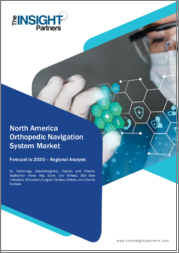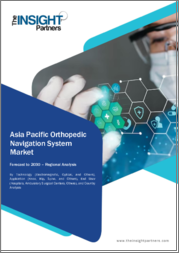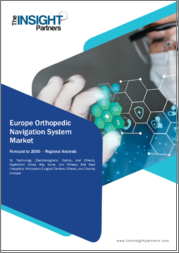
|
시장보고서
상품코드
1425168
정형외과 내비게이션 시스템 : 예측(2024-2029년)Orthopedic Navigation systems - Forecasts From 2024 To 2029 |
||||||
정형외과 내비게이션 시스템 시장은 예측 기간 중 CAGR 10.52%로 성장할 것으로 예측되고 있습니다.
네비게이션 시스템은 정형외과 의사에게 가장 중요한 툴로, 수술 중 정확도를 높이고 X-선 노출을 줄이는 데 도움을 줍니다. 종합적인 시각화 시스템을 촉진하는 이 기술은 3D CT 스캔을 사용하여 수술 부위의 2D 및 3D 뷰를 모두 제공합니다. 외과 의사는 고정밀 탐색을 위해 디스플레이 지연을 최소화하고 툴의 위치에 따라 실시간으로 뷰의 방향을 조정할 수 있습니다.
내비게이션 시스템과 영상 기술의 통합은 덜 침습적인 수술에 기여하여 감염 위험을 줄이고, 흉터를 줄이며, 재활 기간을 단축하는 데 도움이 됩니다. 내비게이션 시스템은 환자의 좌표계에 대한 수술 기구의 위치를 정확하게 추적하여 수술 내내 정확한 안내를 보장합니다.
시장 성장 촉진요인
- 최소침습 수술의 부상
전 세계에서 최소침습수술(MIS)은 기존 개복수술에 비해 통증 감소, 흉터 감소, 입원 기간 단축 등 다양한 이점을 제공합니다. 수술 전 영상진단과 수술 중 내비게이션의 발전으로 MIS 수술의 범위가 넓어지고, 기존 개복 수술에 비해 회복 시간이 단축되는 경우가 많습니다. 외과의사는 절개 부위를 최소화하기 위해 더 작은 기구를 사용하게 되었으며, 더 정밀한 내비게이션 시스템을 사용해야 할 필요성이 높아졌습니다. 이러한 진화를 통해 수술용 내비게이션은 정형외과수술의 최첨단 기술로 자리매김하고 있으며, 환자의 수술 결과와 수술 후 경험을 개선하는 데 큰 진전을 이루었습니다.
- 로봇 수술 도입 증가
정형외과 분야에서 로봇 공학의 도입이 급증하고 있는데, 그 주요 이유는 특히 복잡한 수술에서 정확도와 정밀도를 높일 수 있기 때문입니다. 정형외과 내비게이션 시스템과 로봇 플랫폼의 통합은 그 능력을 더욱 증폭시킬 것입니다. 다양한 로봇 보조 최소 침습 수술(MIS) 시스템의 개발 및 보급은 상당한 가속화와 성장을 경험하고 있습니다.
이러한 로봇 보조 기술은 외과수술에 대한 기존의 접근 방식에 혁명을 일으키고 있습니다. 로봇 보조 정형외과수술의 인기가 높아지는 이유는 기존 MIS 수술에 비해 수술 결과의 정확성과 정밀도 향상, 재현성 강화, 전체 MIS 수술 시간의 현저한 단축 등 잠재적 이점이 있기 때문입니다. 중요한 것은 이러한 로봇 보조 수술은 기존 MIS 수술의 특징인 방사선 노출을 제거하여 정형외과 분야의 매력과 채택에 더욱 기여하고 있다는 점입니다.
용도별로 정형외과 내비게이션 시스템 시장은 무릎관절, 고관절, 척추 수술로 나뉩니다.
정형외과 내비게이션 시스템은 외과 의사가 임플란트를 정확하게 배치할 수 있도록 돕는 데 중요한 역할을 합니다. 척추 수술의 경우, 외과 의사가 임플란트를 정확하게 배치하고 척추의 전반적인 정렬을 유지하여 이러한 복잡한 수술의 성공과 더 나은 시술 도입를 보장합니다. 무릎 관절 수술의 경우, 전 세계에서 노인 인구가 증가함에 따라 이 분야는 상당한 점유율을 차지할 것으로 예상됩니다. 마찬가지로 고관절 수술에서도 인구 통계학적 변화가 중요한 역할을 할 것으로 예상됩니다.
북미는 정형외과 내비게이션 시스템 시장에서 큰 비중을 차지할 것으로 예상됩니다.
북미 정형외과 내비게이션 시스템 시장은 여러 요인의 영향을 받아 주목할 만한 점유율을 차지할 것으로 예상됩니다. 이 지역에서는 고령화 및 라이프스타일 관련 요인으로 인해 정형외과수술에 대한 수요가 증가하고 있습니다. 특히 미국의 노인 인구는 2020년 5,580만 명으로 전체 인구의 16.8%를 차지합니다. 2020년에는 미국 인구 6명 중 1명이 65세 이상입니다. 이러한 인구 통계학은 정형외과수술에 대한 수요 증가의 주요 원동력이 되고 있으며, 그 결과 정형외과 내비게이션 시스템과 같은 첨단 기술에 대한 수요가 증가하고 있습니다. 이러한 시스템은 정형외과수술의 정확성과 효과를 높이는 데 중요한 역할을 하고 있습니다. 고령화 사회가 진행됨에 따라 정형외과수술에 대한 수요가 증가하면서 북미에서의 정형외과 내비게이션 시스템 도입이 더욱 가속화될 것으로 예상됩니다.
회사 제품
- RSIP Vision.-RSIP Vision 내비게이션 시스템은 실시간 추적을 통해 외과 의사의 툴팁과 그 방향을 지속적으로 업데이트하며, 추적 시스템에서 초당 약 25-30프레임의 속도로 전송되는 이 동적 변환은 시스템의 "세계"와 3D CT의 "세계"를 연결하는 역할을 합니다. 변환은 시스템의 "세계"와 3D CT의 "세계"를 연결하는 역할을 합니다. 이 변환을 통해 알고리즘은 3D CT 스캔에서 공구 팁의 정확한 위치와 방향을 효율적으로 계산합니다.
- NaviPro(R) Knee - NaviPro(R) Knee Navigation System은 컴퓨터 지원 수술 기구 탐색을 용이하게 하도록 설계되었으며, 특히 슬관절 전치환술에서 대퇴골 원위부 및 경골 근위부의 정확한 절제술을 지원하는 데 중점을 두고 있습니다. 또한 이 시스템은 수술 중 굴곡 운동 범위와 인대 균형을 측정할 수 있으며, 외과의에게 귀중한 인사이트을 제공하며, NaviPro 시스템의 중요한 특징은 골반 추적기가 필요 없이 단일 핀 또는 이중 핀 고정 옵션을 제공하는 추적기 고정의 유연성입니다. 이러한 간소화된 접근 방식은 무릎 인공관절 전치환술의 효율성과 정확성을 향상시켜 NaviPro(R) Knee 내비게이션 시스템을 정형외과 의사에게 가치 있는 툴로 만들어 줍니다.
- OrthoPilot 내비게이션 시스템 - Aesculap과 임상 사용자들이 공동으로 개발한 OrthoPilot 내비게이션 시스템은 수술 워크플로우를 향상시키고 최적의 임플란트 정렬을 달성하기 위해 설계된 컴퓨터 지원 및 영상이 필요 없는 내비게이션 시스템입니다. 컴퓨터 지원, 영상이 필요 없는 네비게이션 시스템입니다. 이 시스템은 외과 의사의 구체적인 필요와 요구를 충족시키기 위해 무릎 인공관절 치환술(TKR) 및 슬관절 전치환술(TKA)을 위한 옵션 모듈을 제공하며, OrthoPilot의 주요 특징은 컴팩트한 크기로 모든 수술실에 원활하게 통합될 수 있는 다목적성이다, 다재다능하다는 점입니다. 또한 3 페달 풋 스위치와 19인치 터치스크린으로 직관적인 조작이 가능합니다.
목차
제1장 서론
- 시장 개요
- 시장의 정의
- 조사 범위
- 시장 세분화
- 통화
- 전제조건
- 기준년과 예측년 타임라인
제2장 조사 방법
- 조사 데이터
- 조사 방법
제3장 주요 요약
- 조사 하이라이트
제4장 시장 역학
- 시장 촉진요인
- 시장 억제요인
- Porter's Five Forces 분석
- 업계 밸류체인 분석
제5장 정형외과 내비게이션 시스템 시장 : 용도별
- 서론
- 슬관절
- 고관절
- 척추
제6장 정형외과 내비게이션 시스템 시장 : 기술별
- 서론
- 전자
- 광학
- 기타
제7장 정형외과 내비게이션 시스템 시장 : 최종사용자별
- 서론
- 병원
- 외래 수술 센터
제8장 정형외과 내비게이션 시스템 시장 : 지역별
- 서론
- 북미
- 미국
- 캐나다
- 멕시코
- 남미
- 브라질
- 아르헨티나
- 기타
- 유럽
- 영국
- 독일
- 프랑스
- 스페인
- 기타
- 중동 및 아프리카
- 사우디아라비아
- 아랍에미리트
- 이스라엘
- 기타
- 아시아태평양
- 일본
- 중국
- 인도
- 한국
- 인도네시아
- 태국
제9장 경쟁 환경과 분석
- 주요 기업과 전략 분석
- 시장 점유율 분석
- 합병, 인수, 합의 및 협업
제10장 기업 개요
- RSIP Vision
- Kinamed Incorporated
- Aesculap Implant Systems
- Medtronic
- Zimmer Biomet
- Pixee Medical
- Mtetronor
- Intech Medical
- Conmed Corporation
The orthopedic navigation systems market is estimated to grow at a CAGR of 10.52% during the forecast period.
The navigation system stands as a paramount tool for orthopedic surgeons, offering enhanced precision and reduced exposure to X-ray radiations during surgical procedures. Facilitating a comprehensive visualization system, this technology provides both 2D and 3D views of the surgical site using 3D CT scans. Surgeons can adjust the view orientation to align with the tools' positioning in real-time, minimizing display delays for high-accuracy navigation.
The integration of a navigation system with imaging techniques contributes to less invasive surgical operations, resulting in a diminished risk of infection, smaller scars, and shorter rehabilitation periods. The navigation system diligently tracks the positions of surgical tools relative to the patient's coordinate systems, ensuring precise guidance throughout the procedure.
Market Drivers
- Rise of minimally invasive surgical procedure
Globally, minimally invasive surgeries (MIS) present numerous advantages compared to traditional open surgeries, including diminished pain, reduced scarring, and shorter hospitalization periods. Advances in preoperative imaging and intraoperative navigation have expanded the scope of MIS techniques, often resulting in swifter recovery times in comparison to conventional open procedures. Surgeons are employing diminutive tools to minimize incisions, necessitating the utilization of more precise navigation systems. This evolution positions surgical navigation as the forefront technology in orthopedic surgery, marking a significant stride towards enhancing patient outcomes and postoperative experiences.
- Increasing adoption of robotics surgery
The field of orthopedic surgery is witnessing a surge in the adoption of robotics, primarily owing to its capacity for heightened precision and accuracy, especially in intricate procedures. The integration of orthopedic navigation systems with robotic platforms further amplifies their capabilities. The development and widespread deployment of various robot-assisted minimally invasive surgery (MIS) systems have experienced significant acceleration and growth.
These robot-assisted techniques are revolutionizing the traditional approaches to conducting surgical procedures. The increasing popularity of robot-assisted orthopedic surgeries stems from their potential advantages, including elevated accuracy and precision in surgical outcomes, enhanced reproducibility, and a notable reduction in overall MIS operative time when compared to conventional MIS techniques. Importantly, these robot-assisted procedures eliminate the radiation exposure inherent in traditional MIS procedures, further contributing to their appeal and adoption in the field of orthopedic surgery.
By application, the orthopedic navigation systems market is divided into knee, hip, and spine surgery
Orthopedic navigation systems play a crucial role in assisting surgeons in the precise placement of implants. In spine surgeries, it supports surgeons in accurately placing implants, contributing to the overall alignment of the spine, and ensuring the success and better procedural development of these intricate surgeries. In knee surgeries, the segment is anticipated to show a notable share owing to the growing elderly population around the world. Similarly, with hip surgeries, the changing demographic of the population would play an important role.
North America is anticipated to hold a significant share of the orthopedic navigation systems market.
The North American orthopedic navigation systems market in is expected to command a notable share, influenced by multiple factors. The prevalence of aging populations and lifestyle-related factors contribute to a high demand for orthopedic surgeries in the region. Notably, the older population in the United States reached 55.8 million in 2020, accounting for 16.8% of the total population. The demographic shift is evident, with approximately 1 in 6 people in the U.S. being aged 65 and over in 2020. This demographic landscape is a key driver for the rising demand for orthopedic surgeries, and consequently, there is an increased need for advanced technologies such as orthopedic navigation systems. These systems play a crucial role in enhancing the precision and effectiveness of orthopedic procedures. As the aging population continues to grow, the demand for orthopedic surgeries is expected to rise, further fueling the adoption of orthopedic navigation systems in North America.
Market Developments
- October 2022- XPlan.ai, a subsidiary of RSIP Vision renowned for its innovative AI technologies in medical imaging, unveiled successful preliminary results from an ongoing clinical study conducted at Assuta Medical Center in Tel Aviv. The study evaluates the effectiveness of reconstructing a 3D knee model from 2D X-ray images using XPlan.ai's XPlan 2D-to-3D Knee Bones Reconstruction technology. Powered by novel, patent-pending technology, this tool leverages advanced artificial intelligence (AI) to generate a precise 3D model of the knee from two X-ray images, specifically the Anteroposterior and lateral views.
- September 2022- Zimmer Biomet Holdings, Inc. announced an exclusive, multi-year co-marketing collaboration with Surgical Planning Associates, Inc. for the commercialization of HipInsight™, recognized as the inaugural FDA-cleared mixed reality navigation system for total hip replacement. Tailored to Zimmer Biomet's hip implant portfolio, HipInsight offers surgeons the innovative capability to utilize Microsoft HoloLens 2 glasses during surgery. This allows them to visualize a holographic representation of the patient's pelvic anatomy projected directly onto the pelvis, supporting precise implant placement and alignment.
- June 2022- CONMED successfully finalized the acquisition of In2Bones Global, Inc. In2Bones is a prominent global entity engaged in the development, manufacturing, and distribution of medical devices specifically designed for addressing disorders and injuries affecting both the upper extremities (hand, wrist, elbow) and lower extremities (foot and ankle). The company boasts a comprehensive product portfolio that encompasses implants, fracture systems, biologics, and associated hardware. This strategic acquisition positions CONMED to further enhance its offerings and capabilities in the realm of medical devices for the treatment of extremity-related medical conditions.
Company Products
- RSIP Vision.- In the RSIP Vision navigation system, real-time tracking provides a continuous update on the surgeon's tooltip and its orientation. This dynamic transformation, transmitted by the tracking system at a rapid rate of approximately 25-30 frames per second, serves as a link between the system's "world" and the 3D CT "world." Leveraging this transformation, the algorithm efficiently computes the precise location and orientation of the tool's tip within the 3D CT scans.
- NaviPro® Knee- The naviPro® Knee navigation system is designed to facilitate computer-aided navigation of surgical instruments, with a specific focus on aiding the precise resection of the distal femur and proximal tibia during total knee arthroplasty. Additionally, this system enables intra-operative measurements of flexion range of motion and ligament balance, offering valuable insights to the surgeon. An important feature of the NaviPro system is its flexibility in tracker fixation, offering options for single-pin or dual-pin fixation without the need for a pelvic tracker. This streamlined approach enhances the efficiency and accuracy of total knee arthroplasty procedures, making the NaviPro® Knee navigation system a valuable tool for orthopedic surgeons.
- OrthoPilot Navigation System- The OrthoPilot Navigation System, a product of collaborative development between Aesculap and clinical users, stands as a computer-aided, image-free navigation system designed to enhance surgical workflows and achieve optimal implant alignment. Tailored to address the specific needs and requests of surgeons, the system offers optional modules for Total Knee Replacement (TKR) and Total Knee Arthroplasty (TKA). Key Features of OrthoPilot include its compact size which allows for seamless integration into any operating room, promoting versatility. The system is designed for user-friendly control, featuring a 3-pedal foot switch and a 19" touch screen for intuitive operation.
Market Segmentation
By Application
- Knee
- Hip
- Spine
By Technology
- Electromagnetic
- Optical
- Others
By End-user
- Hospitals
- Ambulatory Surgical Centers
By Geography
- North America
- USA
- Canada
- Mexico
- South America
- Brazil
- Argentina
- Others
- Europe
- UK
- Germany
- France
- Spain
- Others
- Middle East and Africa
- Saudi Arabia
- UAE
- Israel
- Others
- Asia Pacific
- Japan
- China
- India
- South Korea
- Indonesia
- Thailand
- Others
TABLE OF CONTENTS
1. INTRODUCTION
- 1.1. Market Overview
- 1.2. Market Definition
- 1.3. Scope of the Study
- 1.4. Market Segmentation
- 1.5. Currency
- 1.6. Assumptions
- 1.7. Base, and Forecast Years Timeline
2. RESEARCH METHODOLOGY
- 2.1. Research Data
- 2.2. Research Methods
3. EXECUTIVE SUMMARY
- 3.1. Research Highlights
4. MARKET DYNAMICS
- 4.1. Market Drivers
- 4.2. Market Restraints
- 4.3. Porter's Five Force Analysis
- 4.3.1. Bargaining Power of Suppliers
- 4.3.2. Bargaining Power of Buyers
- 4.3.3. Threat of New Entrants
- 4.3.4. Threat of Substitutes
- 4.3.5. Competitive Rivalry in the Industry
- 4.4. Industry Value Chain Analysis
5. ORTHOPEDIC NAVIGATION SYSTEMS MARKET BY APPLICATION
- 5.1. Introduction
- 5.2. Knee
- 5.3. Hip
- 5.4. Spine
6. ORTHOPEDIC NAVIGATION SYSTEMS MARKET BY TECHNOLOGY
- 6.1. Introduction
- 6.2. Electromagnetic
- 6.3. Optical
- 6.4. Others
7. ORTHOPEDIC NAVIGATION SYSTEMS MARKET BY END-USER
- 7.1. Introduction
- 7.2. Hospitals
- 7.3. Ambulatory Surgical Centers
8. ORTHOPEDIC NAVIGATION SYSTEMS MARKET BY GEOGRAPHY
- 8.1. Introduction
- 8.2. North America
- 8.2.1. United States
- 8.2.2. Canada
- 8.2.3. Mexico
- 8.3. South America
- 8.3.1. Brazil
- 8.3.2. Argentina
- 8.3.3. Others
- 8.4. Europe
- 8.4.1. United Kingdom
- 8.4.2. Germany
- 8.4.3. France
- 8.4.4. Spain
- 8.4.5. Others
- 8.5. The Middle East and Africa
- 8.5.1. Saudi Arabia
- 8.5.2. UAE
- 8.5.3. Israel
- 8.5.4. Others
- 8.6. Asia Pacific
- 8.6.1. Japan
- 8.6.2. China
- 8.6.3. India
- 8.6.4. South Korea
- 8.6.5. Indonesia
- 8.6.6. Thailand
9. COMPETITIVE ENVIRONMENT AND ANALYSIS
- 9.1. Major Players and Strategy Analysis
- 9.2. Market Share Analysis
- 9.3. Mergers, Acquisitions, Agreements, and Collaborations
10. COMPANY PROFILES
- 10.1. RSIP Vision
- 10.2. Kinamed Incorporated
- 10.3. Aesculap Implant Systems
- 10.4. Medtronic
- 10.5. Zimmer Biomet
- 10.6. Pixee Medical
- 10.7. Mtetronor
- 10.8. Intech Medical
- 10.9. Conmed Corporation


















